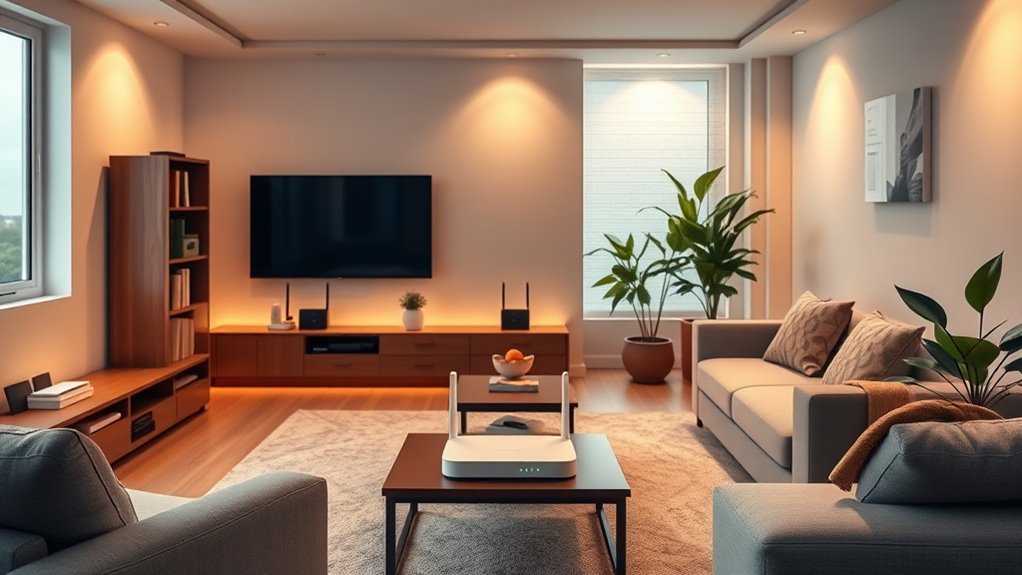If you’re looking for the best mesh Wi-Fi systems for seamless home coverage in 2025, I recommend checking out options like the TP-Link Deco X55, Amazon eero 6, and NETGEAR Orbi 370, which offer extensive coverage, fast speeds, and easy setup. From large homes to smart home setups, these systems excel in handling multiple devices and providing reliable Wi-Fi. Keep exploring to discover more about each system and find the perfect fit for your needs.
Key Takeaways
- The list includes top mesh Wi-Fi systems supporting Wi-Fi 6, Wi-Fi 6E, and Wi-Fi 7 for fast, reliable connectivity.
- Coverage ranges from 4,500 to over 7,200 square feet, suitable for large or multi-story homes.
- Features such as easy setup, app management, and wired backhaul enhance user experience and system stability.
- Devices support high device counts (up to 200), ideal for smart homes with many connected gadgets.
- Pros and cons include coverage, speeds, security features, and considerations like cost and compatibility.
TP-Link Deco X55 AX3000 WiFi 6 Mesh System (3-Pack)

The TP-Link Deco X55 AX3000 Mesh System is an excellent choice for large households that need reliable, high-speed Wi-Fi across every corner of their home. Covering up to 6,500 sq.ft., it replaces traditional routers and extenders, providing seamless connectivity. Supporting Wi-Fi 6, it delivers speeds of 2402 Mbps plus 574 Mbps, handling up to 150 devices simultaneously. Its AI-driven mesh technology learns your home environment to optimize coverage, while Ethernet backhaul boosts wired speeds. Easy to set up via the Deco app, the system guarantees stable, fast performance, minimizes dead zones, and adapts effortlessly to busy households with multiple devices.
Best For: households and large homes needing reliable, high-speed Wi-Fi coverage for multiple devices and seamless internet throughout expansive areas.
Pros:
- Covers up to 6,500 sq.ft. with strong and stable Wi-Fi 6 performance
- Supports up to 150 devices simultaneously, ideal for busy households
- Easy setup and management via the intuitive Deco app with advanced security features
Cons:
- Higher cost compared to traditional routers or extenders
- Requires compatible devices to fully utilize Wi-Fi 6 speeds
- May be overkill for small homes or users with minimal device needs
TP-Link Deco S4 Mesh WiFi System (3-Pack)

Looking for a reliable WiFi solution that covers large homes or multi-building properties without the hassle of running cables? The TP-Link Deco S4 Mesh WiFi System (3-Pack) offers seamless coverage up to 5,500 sq.ft., eliminating dead zones. Its Deco Mesh technology guarantees fast speeds and strong signals in all directions, with devices automatically switching to the best unit. Setup is simple via the Deco app, and the system supports up to 100 devices. With Ethernet backhaul options and compatibility with major ISPs, it’s a flexible, affordable choice for stable, large-area WiFi. Users praise its ease of use and reliable performance across extensive spaces.
Best For: homeowners and multi-building property owners seeking reliable, large-area WiFi coverage without extensive wiring or complex setup.
Pros:
- Seamless coverage up to 5,500 sq.ft. with mesh technology eliminating dead zones
- Easy setup and management via user-friendly Deco app on Android or iOS
- Supports up to 100 devices with fast AC1900 speeds and Ethernet backhaul options
Cons:
- Firmware updates may require manual intervention through web UI
- Some users report occasional connectivity or firmware update issues
- Advanced network management features are limited for power users
Amazon eero 6 Mesh WiFi System (3-Pack)

If you’re seeking a simple, reliable mesh Wi-Fi system that covers large homes without requiring technical expertise, the Amazon eero 6 Mesh WiFi System (3-Pack) is an excellent choice. It supports internet plans up to 500 Mbps and covers up to 4,500–5,000 sq ft with one router and two extenders. Using Wi-Fi 6 dual-band technology, it’s compatible with older devices and can handle over 75 connected gadgets. Setup is quick via the eero app, and it doubles as a Zigbee smart home hub. While some advanced features are limited or buggy, most users find the system easy to manage and effective at eliminating dead spots.
Best For: households seeking an easy-to-set-up, reliable mesh Wi-Fi system to cover large areas without advanced technical knowledge.
Pros:
- Simple setup and management via the user-friendly eero app
- Seamless coverage of large homes up to 5,000 sq ft with 3-pack system
- Supports over 75 devices with stable Wi-Fi 6 dual-band technology
Cons:
- Limited advanced features and some buggy or non-functional options
- Potential issues with ISP DHCP and IP address assignment delays
- Price is relatively high compared to other mesh systems on the market
TP-Link Deco XE75 AXE5400 Mesh System (3-Pack)

For homeowners with large, multi-story spaces or outdoor areas, the TP-Link Deco XE75 AXE5400 Mesh System (3-Pack) stands out as an excellent solution. Covering up to 7,200 sq. ft., it uses WiFi 6E tri-band technology, including a dedicated 6 GHz band that reduces interference and boosts performance. With speeds up to 5,400 Mbps and support for 200 devices, it handles streaming, gaming, and smart home gadgets effortlessly. Easy to set up via the Deco app, it offers seamless device roaming, security features, and compatibility with voice commands. Its expandability makes it perfect for both large homes and outdoor spaces, ensuring reliable, high-speed connectivity everywhere.
Best For: homeowners with large, multi-story spaces or outdoor areas seeking reliable, high-speed WiFi coverage and seamless device connectivity.
Pros:
- Tri-band WiFi 6E technology with dedicated 6 GHz band for minimized interference and enhanced performance
- Extensive coverage up to 7,200 sq. ft. suitable for large homes and outdoor spaces
- Easy setup via the Deco app with seamless device roaming and security features
Cons:
- Requires a compatible modem, which may add to initial setup costs
- Slightly higher price point compared to traditional WiFi 5 systems
- Limited advanced customization options for network management compared to enterprise solutions
NETGEAR Orbi 370 Series Dual-Band WiFi 7 Mesh Network System
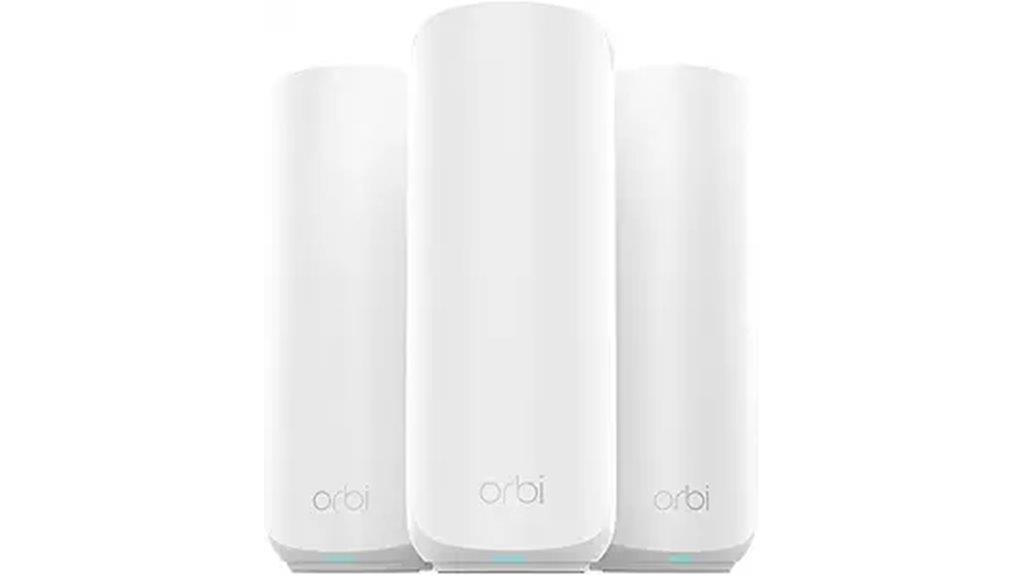
The NETGEAR Orbi 370 Series Dual-Band WiFi 7 Mesh Network System is an excellent choice for large homes with multiple devices, thanks to its robust coverage and high-speed performance. It delivers speeds up to 5Gbps, supporting around 70 devices across up to 6,000 sq.ft. with a router and two extenders. Equipped with advanced antennas and 3-channel connectivity, it ensures strong 360° WiFi, even on multi-story structures. The system features a sleek design, easy setup via the Orbi app, and compatibility with any ISP. It reliably handles streaming, gaming, and smart home functions, making it ideal for demanding households.
Best For: households with large, multi-story homes and numerous devices seeking fast, reliable WiFi coverage for streaming, gaming, and smart home use.
Pros:
- Delivers high-speed WiFi up to 5Gbps suitable for demanding activities.
- Provides extensive coverage up to 6,000 sq.ft. with a router and two extenders.
- Supports around 70 devices simultaneously with strong, stable connections.
Cons:
- Premium price point may be a barrier for some users.
- Occasional connectivity issues or physical defects reported by a few customers.
- Wired satellite connections are recommended for optimal performance, which may require additional setup.
TP-Link Deco M5 Mesh WiFi System (3-Pack)
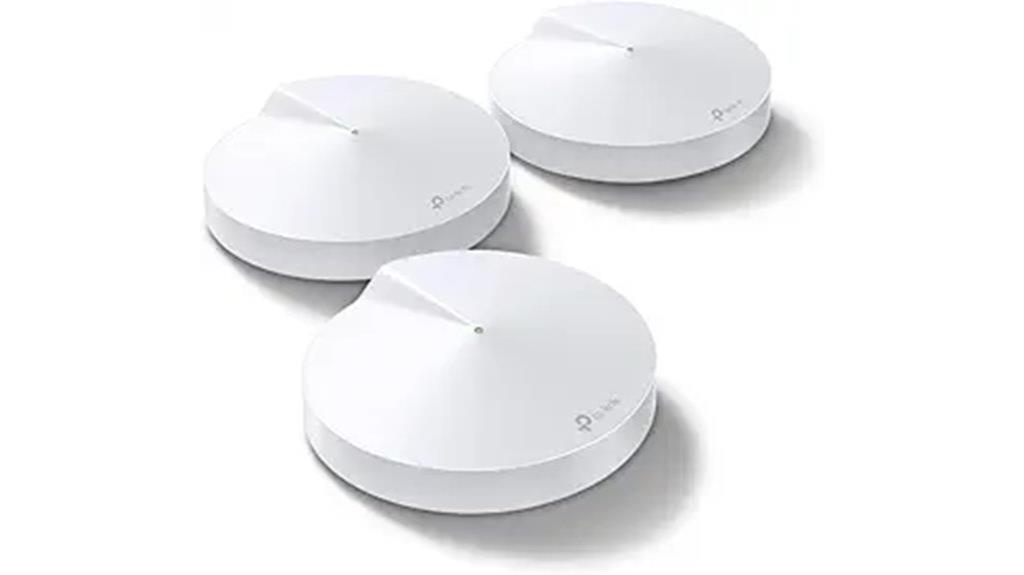
The TP-Link Deco M5 Mesh WiFi System (3-Pack) stands out as an excellent choice for households needing seamless coverage across large or complex spaces. It provides up to 5,500 sq. ft. of reliable Wi-Fi, supporting over 100 devices. The system replaces traditional routers and extenders, eliminating dead zones with a flexible mesh network. Setup is quick via the Deco app, and it works with all major ISPs. With wired Ethernet backhaul options, speeds stay fast and stable. While it’s simple to use and visually appealing, it lacks wall mounts and may run warm. Overall, it’s a practical, affordable solution for broad, consistent home coverage.
Best For: households seeking easy-to-set-up, reliable whole-home Wi-Fi coverage with support for numerous devices and minimal technical hassle.
Pros:
- Simple setup via user-friendly Deco app that takes minutes to complete
- Seamless coverage up to 5,500 sq. ft. with mesh network eliminating dead zones
- Supports wired Ethernet backhaul for stable, high-speed connections
Cons:
- Lacks wall mounting options, requiring separate mounts for wall installation
- Units can run warm during extended use, potentially affecting placement
- Limited advanced customization features, such as manual channel selection, for tech-savvy users
Amazon eero 6+ Mesh WiFi System (3-Pack)
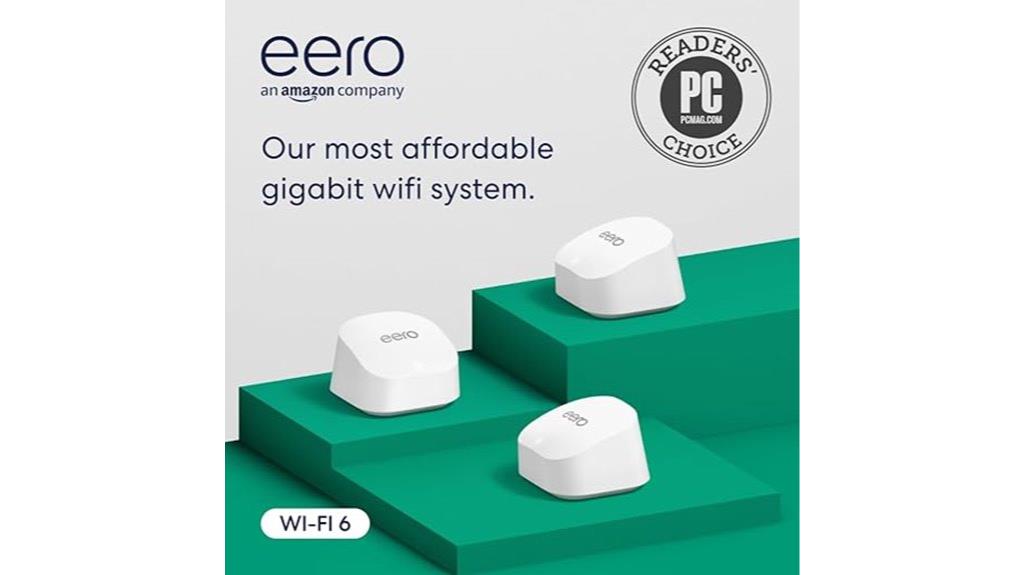
If you’re looking to cover a large home with fast, reliable Wi-Fi, the Amazon eero 6+ Mesh WiFi System (3-Pack) stands out as a top choice. It supports internet plans up to a gigabit and offers Wi-Fi 6 dual-band connectivity with AX3000 speeds. Covering up to 4,500 sq ft, it’s perfect for big homes, and can handle 75+ devices simultaneously, ensuring smooth streaming, gaming, and smart home control. Setup is quick via the eero app, and its TrueMesh technology intelligently routes traffic to eliminate dead zones. Reliable, secure, and easy to expand, it’s a solid investment for seamless coverage in 2025.
Best For: households seeking fast, reliable, and seamless Wi-Fi coverage across large homes with multiple devices and smart home integration.
Pros:
- Supports internet plans up to 1 Gbps with Wi-Fi 6 AX3000 speeds for fast connectivity
- Covers up to 4,500 sq ft with a 3-pack mesh system, ideal for large homes and outdoor spaces
- Easy setup via the eero app, with intelligent traffic routing for stable, dead-zone-free coverage
Cons:
- Higher initial cost compared to traditional routers and older mesh systems
- Limited Ethernet ports per node, which may require switches for wired connections
- Dependence on cloud management and internet connectivity for full functionality
TP-Link Deco WiFi 6 Mesh System (Deco X20)
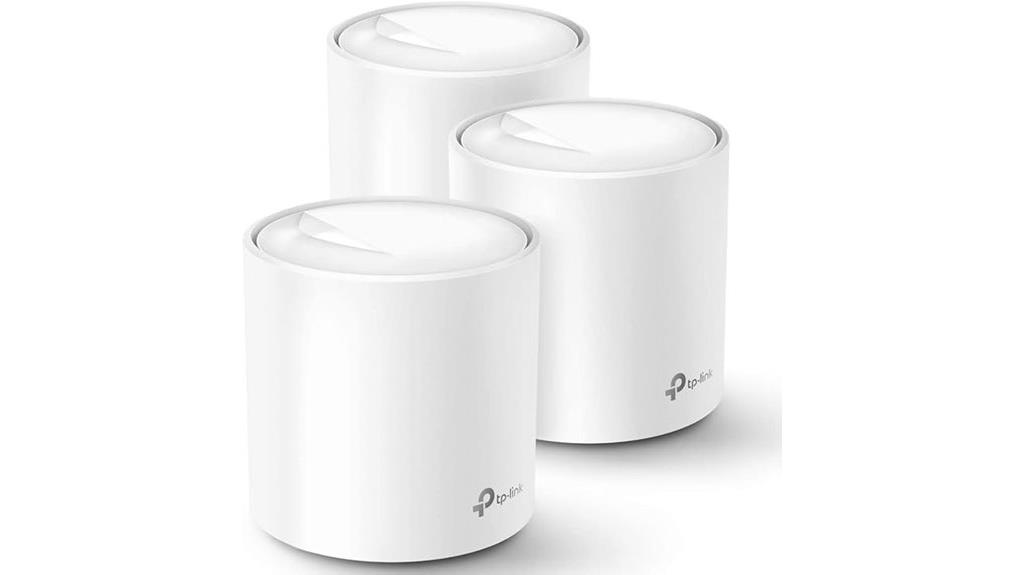
For large homes or multi-story buildings where reliable Wi-Fi coverage is essential, the TP-Link Deco WiFi 6 Mesh System (Deco X20) stands out as an excellent solution. Covering up to 5800 sq ft with a 3-pack, it uses Wi-Fi 6 AX1800 technology to eliminate dead zones, buffering, and weak signals. It supports up to 150 devices simultaneously and offers wired Ethernet backhaul with two gigabit ports per unit. Setup via the Deco app is simple, and the system integrates voice control with Alexa. Customers praise its fast, stable connections, ease of installation, and ability to handle high-bandwidth activities, making it a versatile choice for large homes.
Best For: households or multi-story buildings requiring extensive, reliable Wi-Fi coverage for many devices and high-bandwidth activities.
Pros:
- Seamless coverage up to 5800 sq ft with a 3-pack system, ideal for large homes
- Supports Wi-Fi 6 AX1800 technology, providing faster speeds and stable connections for multiple devices
- Easy setup via the Deco app with remote management and voice control compatibility with Alexa
Cons:
- Limited to 150 devices, which may be insufficient for very dense smart home networks
- Requires wired Ethernet backhaul for optimal performance, which may not be available in all homes
- Some users report occasional connectivity issues or firmware updates needing attention
TP-Link Deco XE70 Pro WiFi 6E Mesh System (3 Pack)
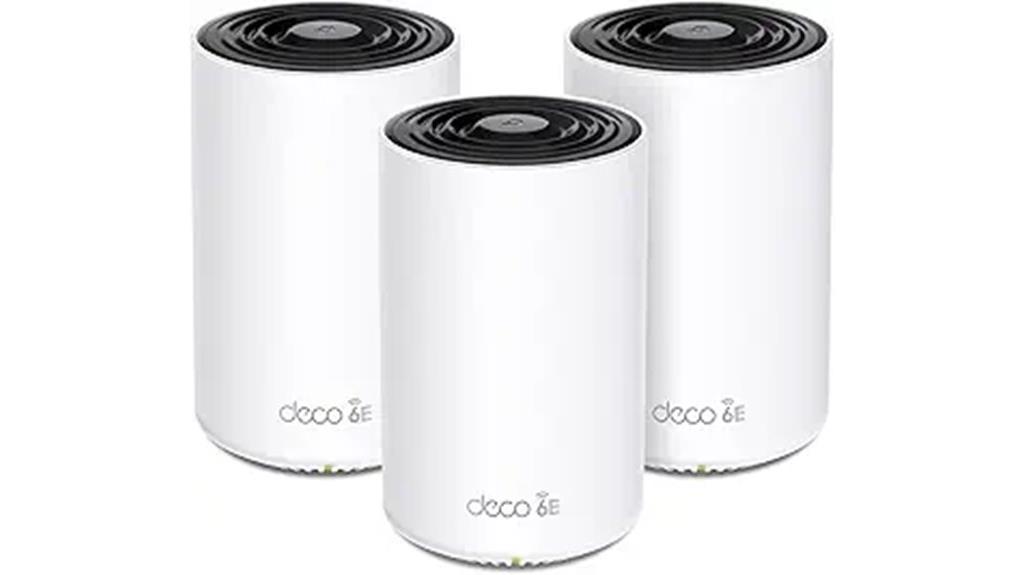
When you need seamless Wi-Fi coverage for a large or multi-story home, the TP-Link Deco XE70 Pro WiFi 6E Mesh System (3 Pack) stands out as an excellent choice. It offers up to 7,200 sq. ft. of reliable coverage and supports up to 200 devices simultaneously. With lightning-fast speeds up to 4.9 Gbps across three bands, including a congestion-free 6 GHz band, it handles streaming, gaming, and smart home devices effortlessly. The system includes wired ports for high-speed connections and uses AI-powered mesh technology for seamless roaming. Easy to set up via the Deco app, it provides advanced security features, making it ideal for modern, connected households.
Best For: households needing extensive, reliable Wi-Fi coverage with high device capacity and fast speeds across large or multi-story homes.
Pros:
- Provides up to 7,200 sq. ft. coverage with support for 200 devices simultaneously
- Supports lightning-fast Wi-Fi speeds up to 4.9 Gbps across three bands, including Wi-Fi 6E’s 6 GHz band
- Easy setup and management via the Deco app with advanced security features
Cons:
- Higher price point compared to basic routers or less advanced mesh systems
- Requires compatible modem or bridge mode setup for existing internet services
- Tri-band design and advanced features may be more complex for extremely basic users
NETGEAR Nighthawk Tri-Band Mesh WiFi 6 System (MK73S)

The NETGEAR Nighthawk Tri-Band Mesh WiFi 6 System (MK73S) is an excellent choice for those needing reliable, high-speed coverage across large homes. It includes a router and two satellite extenders, covering up to 4,500 sq. ft. and supporting over 25 devices simultaneously. With AX3000 WiFi 6 technology, it delivers fast, dependable speeds perfect for streaming, gaming, and video calls. The system offers wired connections via three 1G Ethernet ports and features robust security with NETGEAR Armor. Easy to set up through the Nighthawk app, it’s designed for seamless, secure home connectivity, making it a top contender for 2025.
Best For: households needing extensive, high-speed WiFi coverage with robust security and support for multiple devices in a large home.
Pros:
- Covers up to 4,500 sq. ft. with seamless mesh connectivity
- Supports over 25 devices simultaneously for busy households
- Includes built-in security features with NETGEAR Armor and easy setup via the Nighthawk app
Cons:
- Designed primarily for use in the US, which may limit compatibility elsewhere
- Slightly higher price point compared to basic routers
- Requires power outlets for satellite extenders, which could be a consideration in some setups
Linksys Atlas WiFi 6 Mesh Router System (3-Pack)

If you need reliable, high-speed Wi-Fi coverage for a large home or multiple devices, the Linksys Atlas WiFi 6 Mesh Router System (3-Pack) is an excellent choice. It covers up to 6,000 square feet and supports over 75 devices simultaneously, delivering gigabit speeds up to 3.0 Gbps. Powered by a Qualcomm chipset and WiFi 6 technology, it offers four times the WiFi capacity for stable streaming, gaming, and browsing. The system uses intelligent mesh technology to eliminate dead zones and can be expanded easily. Setup is straightforward via the Linksys app, which also provides control over network management, security, and device prioritization.
Best For: households requiring extensive, high-speed Wi-Fi coverage with support for numerous devices and seamless connectivity across large or multi-story homes.
Pros:
- Covers up to 6,000 sq ft and supports over 75 devices simultaneously.
- Delivers gigabit speeds up to 3.0 Gbps with WiFi 6 technology for fast, reliable connections.
- Easy setup and management via the Linksys app, including security features and network control.
Cons:
- The 3-pack system may be more expensive compared to single-router options.
- Requires a compatible modem and internet plan for optimal performance.
- Some advanced features may need ongoing firmware updates and management through the app.
TP-Link AX1800 WiFi 6 Router V4 (Archer AX21)

The TP-Link AX1800 WiFi 6 Router V4 (Archer AX21) is an excellent choice for those seeking a reliable mesh Wi-Fi system that combines fast speeds and broad coverage. It leverages Wi-Fi 6 technology, delivering up to 1.8 Gbps across dual bands, ideal for streaming, gaming, and multiple devices. Its OFDMA and beamforming features ensure stable connections over extensive areas, while four high-gain antennas enhance coverage. Compatible with major ISPs and supporting easy mesh setup, it offers security controls and a straightforward interface. Overall, the Archer AX21 provides solid performance, security, and value, making it a versatile option for seamless home networking in 2025.
Best For: users seeking a reliable, high-speed mesh Wi-Fi system with extensive coverage and strong security features suitable for streaming, gaming, and multiple devices in a smart home.
Pros:
- Supports Wi-Fi 6 technology with up to 1.8 Gbps bandwidth for fast, stable connections
- Features OFDMA, beamforming, and four high-gain antennas for broad coverage and device capacity
- Easy mesh setup with comprehensive security controls and user-friendly management interface
Cons:
- Occasional connectivity drops reported by some users, possibly due to external factors
- Initial setup of security and advanced configurations may require technical familiarity
- Not the most feature-rich router compared to higher-end models, limiting advanced customization
Google Nest WiFi Pro Mesh Router (3 Pack, Snow)

For those seeking ultra-fast, reliable Wi-Fi coverage across a large home, the Google Nest WiFi Pro Mesh Router (3 Pack, Snow) stands out as an excellent choice. It leverages Wi-Fi 6E technology, supporting speeds up to twice as fast as Wi-Fi 6, with extensive coverage for homes up to 6,600 sq ft. The system uses three bands—2.4 GHz, 5 GHz, and 6 GHz—to optimize performance and guarantee stable connections. Easy to set up with the Google Home app, it automatically adjusts to network conditions and prioritizes activities like video calls. While compatible only with Wi-Fi 6E devices, it offers strong security and seamless coverage, especially in larger or complex spaces.
Best For: households seeking ultra-fast, reliable Wi-Fi coverage over large or complex spaces with multiple floors or outdoor areas.
Pros:
- Supports Wi-Fi 6E technology with speeds up to twice as fast as Wi-Fi 6, ensuring high-performance connections.
- Extensive coverage up to 6,600 sq ft with a 3-pack, ideal for large homes.
- Seamless setup via the Google Home app with automatic performance optimization and activity prioritization.
Cons:
- Compatibility limited to Wi-Fi 6E devices, requiring newer client hardware.
- Ethernet ports support only 1 Gbps, which may be slower than some competing systems with 2.5 Gbps ports.
- Higher price point (~$400 for 3-pack), which may be costly relative to other mesh systems.
Linksys Atlas WiFi 6 Mesh Router (MX2000 2-Pack)

When managing a large home or multiple structures, reliable WiFi coverage becomes essential, and the Linksys Atlas WiFi 6 Mesh Router (MX2000 2-Pack) excels in delivering that. Supporting WiFi 6 technology, it offers speeds up to 3.0 Gbps and extensive coverage of up to 4,000 square feet per unit. The system handles 50+ devices simultaneously with reduced congestion and wire-like stability, thanks to Qualcomm-powered hardware and intelligent mesh technology. Easy to set up via the Linksys app, it allows seamless roaming, device prioritization, and robust security features like WPA3. This system is a dependable choice for large or multi-structure homes demanding high-speed, stable connectivity.
Best For: households with large or multi-structure homes seeking reliable, high-speed WiFi coverage for multiple devices and seamless connectivity.
Pros:
- Supports WiFi 6 technology with speeds up to 3.0 Gbps and extensive coverage up to 4,000 sq ft per unit
- Easy setup and management via the user-friendly Linksys app, including features like device prioritization and parental controls
- Reliable, wire-like stability with reduced congestion and intelligent mesh technology suitable for large homes and multiple structures
Cons:
- Initial setup may pose challenges for some users, requiring support assistance
- The 2-pack system may be more expensive compared to single-router solutions
- Limited detailed customization options for advanced networking users
TP-Link Deco BE67 Tri-Band WiFi 7 Mesh System (3-Pack)
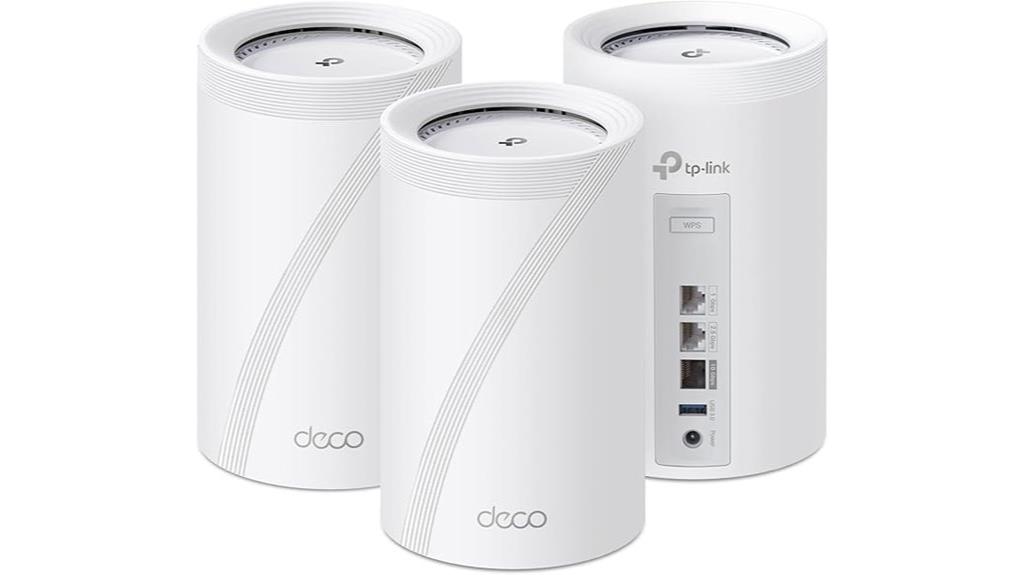
If you’re looking to upgrade your home Wi-Fi with a system that offers blazing-fast speeds and seamless coverage, the TP-Link Deco BE67 Tri-Band WiFi 7 Mesh System (3-Pack) is an excellent choice. It leverages next-generation Wi-Fi 7 technology, supporting up to 14 Gbps across its three bands, ideal for 4K/8K streaming, AR/VR gaming, and quick downloads. Covering up to 8,100 sq. ft. and supporting 200 devices, it ensures reliable, high-speed connections everywhere. With multi-gigabit ports, USB sharing, and advanced security, this mesh system is designed for large homes with demanding internet needs, all managed easily via the Deco app.
Best For: households seeking a high-performance, reliable Wi-Fi 7 mesh system capable of supporting multiple devices and large coverage areas for streaming, gaming, and smart home integration.
Pros:
- Supports ultra-fast Wi-Fi 7 speeds up to 14 Gbps and coverage up to 8,100 sq. ft.
- Easy to set up and manage via the user-friendly Deco app, ideal for non-technical users.
- Multi-gigabit wired ports and USB sharing enhance connectivity options for advanced users.
Cons:
- Limited advanced network configuration options, such as VLAN support in AP mode.
- Some users experience speed discrepancies when integrating with other devices or routers.
- Support for additional networking features like extensive customizations may be limited.
Factors to Consider When Choosing Mesh Wi‑Fi Router Systems
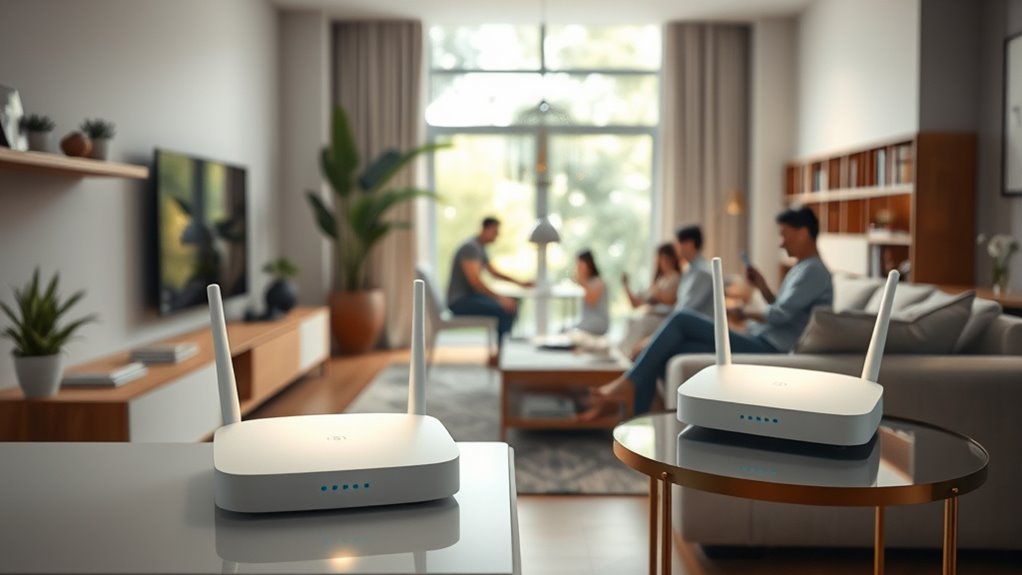
When choosing a mesh Wi‑Fi system, I focus on coverage area to guarantee it fits my home or office. I also consider device compatibility and whether the system can handle my internet speed needs. Security features and ease of setup are equally important to me for a smooth and safe experience.
Coverage Area Needs
How much space do you need to cover with your Wi-Fi? First, measure your home’s total square footage to pick a system that provides enough coverage without dead zones. For larger homes over 5,000 sq ft, you’ll likely need three or more nodes to ensure seamless connectivity everywhere. Multi-story homes benefit from placing nodes on different floors to maintain strong signals vertically. If you have outdoor spaces like yards or patios, consider adding extra nodes or range extenders to extend coverage beyond walls. Keep in mind potential future needs—if you plan to add more devices or expand your home, choose a system that’s scalable and offers sufficient range. Proper planning guarantees reliable Wi-Fi throughout your entire property, now and in the future.
Device Compatibility
Choosing a mesh Wi-Fi system that supports a wide range of devices is essential to guarantee seamless connectivity across your home. I look for systems that support both Wi-Fi 5 (802.11ac) and Wi-Fi 6 (802.11ax), ensuring compatibility with current and future gadgets. It’s important to verify that the system works with my internet provider and supports connection types like Ethernet, DSL, or fiber if needed. I also check if it supports older devices using Wi-Fi 4 (802.11n) to avoid connectivity issues. Additionally, I ensure the management app and firmware are compatible with my smartphone’s OS, whether iOS or Android. If I have smart home devices, I look for compatibility with protocols like Zigbee or Thread to streamline integration.
Internet Speed Demands
Are you getting the most out of your internet speed with your mesh Wi-Fi system? To do so, choose a system that supports speeds at least 20-50% higher than your plan. This prevents bottlenecks and ensures smooth performance. If you have a gigabit internet plan, look for Wi-Fi 6 or Wi-Fi 6E systems that deliver over 1 Gbps across your network. Consider models with multi-gigabit Ethernet ports and wired backhaul options to maximize speed and cut latency, especially if your household does heavy streaming, gaming, or large file transfers. Be mindful that older standards like Wi-Fi 5 may not meet current high-speed demands, limiting your network’s potential. Matching your system’s capabilities with your speed needs guarantees faster, more reliable connectivity for all your devices.
Ease of Setup
Optimizing your internet speed depends not only on choosing a high-performance mesh Wi-Fi system but also on how easily you can set it up. Most systems now use mobile apps that guide you through installation step-by-step, often taking just 15-30 minutes. Devices with automated network configuration and intuitive interfaces make setup accessible, even for beginners. Features like auto-detection of your modem and plug-and-play installation simplify initial connections and reduce troubleshooting. Visual setup instructions and real-time status updates via apps help you quickly identify and fix any issues. Additionally, compatibility with existing infrastructure, such as Ethernet backhaul options, can streamline the process by allowing wired connections during setup. Overall, ease of setup is vital for a smooth, frustration-free experience.
Security Features
Security features are a crucial aspect to take into account when selecting a mesh Wi-Fi system because they protect your network from unauthorized access and potential threats. I look for systems that use advanced protocols like WPA3 encryption, which offers stronger data protection. Automatic firmware updates are essential, as they keep security vulnerabilities patched without requiring my intervention. Features such as network segmentation, guest networks, and device access controls help me isolate sensitive devices and limit unauthorized access. Some systems include integrated security services like threat detection, ad blocking, and IoT device protection, though these often come with subscription fees. Additionally, I consider manufacturers that adhere to industry standards or cybersecurity pledges, as their commitment indicates a focus on secure design practices.
Budget Considerations
Choosing the right mesh Wi-Fi system involves balancing features with your budget. Budget-friendly options typically cost under $150, while premium models can exceed $400, impacting affordability. Investing in features like Ethernet backhaul support or higher device capacity usually raises initial costs but enhances performance, especially in larger homes. Keep in mind that cheaper systems often lack advanced security features and management options found in more expensive, enterprise-grade solutions. Additionally, if you need to expand coverage, adding extra nodes or purchasing multi-packs can increase overall costs. Don’t forget to contemplate the total cost of ownership, including potential subscription fees for enhanced security or parental controls. Carefully evaluating your needs and budget ensures you choose a system that fits both your home and financial plans.
Frequently Asked Questions
How Do Mesh Systems Handle Multiple Device Connections Simultaneously?
Mesh systems handle multiple device connections smoothly by distributing bandwidth evenly across all devices. I’ve seen how they use multiple nodes to create a unified network, reducing congestion and lag. Instead of one router struggling with many devices, the system dynamically manages traffic, ensuring everyone gets fast, reliable internet. This setup really makes my home Wi-Fi seamless, even when multiple people are streaming, gaming, or working online at the same time.
Can Mesh Wi-Fi Systems Be Expanded Beyond Three Units?
Yes, you can definitely expand your mesh Wi-Fi system beyond three units. I’ve found that many systems, like Netgear Orbi or Google Nest, are designed for flexibility, allowing you to add more nodes to cover larger areas. This adaptability guarantees seamless streaming, strong signals, and stable connections everywhere in your home. So, if your space grows or needs change, just add another unit for uninterrupted, unbeatable coverage.
What Is the Typical Lifespan of a Mesh Wi-Fi Router System?
A mesh Wi-Fi router system typically lasts about 3 to 5 years. I’ve found that with proper maintenance, firmware updates, and careful handling, it can sometimes stretch closer to 6 years. After that, performance might decline, or hardware could become outdated as new technology emerges. I recommend keeping an eye on performance and updating or replacing your system when you notice significant slowdowns or connectivity issues.
How Do Mesh Systems Perform in Large or Multi-Story Homes?
Imagine a network of bridges connecting distant islands; that’s how mesh systems work in large or multi-story homes. They perform remarkably well, spreading Wi-Fi evenly across every corner, even between floors. With multiple nodes acting as relays, your signal stays strong and consistent, eliminating dead zones. I’ve seen this setup transform sprawling homes into seamless internet zones, making streaming, gaming, and working from home effortless everywhere.
Are Mesh Wi-Fi Systems Compatible With All Internet Service Providers?
Yes, mesh Wi-Fi systems are generally compatible with most internet service providers. I’ve used mine with various providers without issues, but it’s always smart to double-check your ISP’s compatibility. Some providers might have specific settings or restrictions, so I recommend confirming with them or checking the system’s specifications. Overall, mesh systems are flexible and should work smoothly with your existing internet setup.
Conclusion
Choosing the right mesh Wi-Fi system can truly transform your home’s connectivity. I get it—upgrading feels like a hassle, but imagine streaming seamlessly or working without interruptions. Don’t let tech worries hold you back—investing now means fewer frustrations later. With these top options, you’ll enjoy reliable, fast Wi-Fi everywhere. Trust me, a smoother online experience is worth it, and your digital life will thank you for making the leap today.
